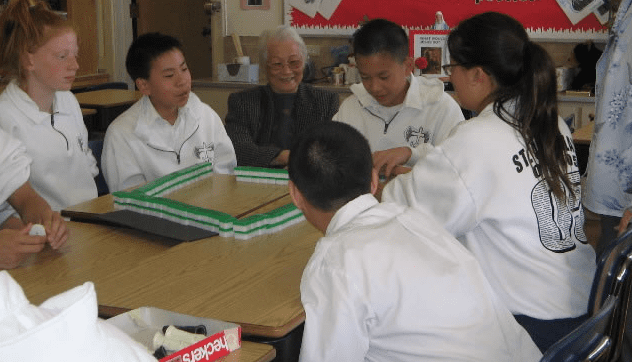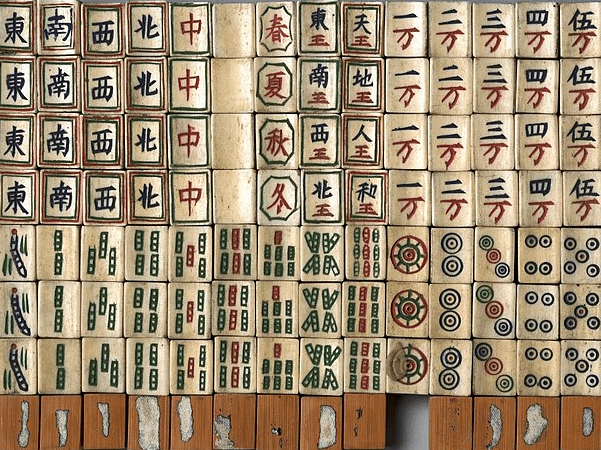Introduction: In this article – in honor of tomorrow being International Mah Jong Day – Gena Philibert-Ortega searches old newspapers to learn more about this Chinese game that was very popular in the U.S. in the 1920s, and is still played today. Gena is a genealogist and author of the book “From the Family Kitchen.”
Do you play Mah Jong? Maybe you have family members who enjoyed playing this game in the 1920s during its heyday in the United States. Mah Jong is a game played with 144 tiles based on Chinese characters and symbols that requires some skill, strategy, and chance. (1) Its U.S. history is interesting, and some of that history is found in old newspapers such as GenealogyBank’s Historical Newspaper Archives.

History
The exact origin of Mah Jong in China is unclear, but it started as a local game 2500 years ago then spread to the Western world in the early 1900s. Early U.S. players of the game were reminded of rummy card games. Rules and rituals of those early Mah Jong games varied depending on the players, just as today. Around 1920, the game was “discovered” by Westerners and from there became popular worldwide. (2)
Learning the Game
Newspapers have been a source for learning game rules and playing games throughout most of the 20th century. During the 1920s when Mah Jong was hitting the U.S. by storm, the newspaper was the perfect place to learn more about the game and its ever-changing rules.
Englishman L. L. Harr is credited with introducing the game to English society. He learned of it as he “…traveled in the intellectual and diplomatic circles in Peking, and among his friends was the distinguished Chinese statesman Li Hung Chang.” Li introduced him to the game that the Chinese called “Pe-ling.” When Harr came back to Europe in 1921, he had five sets of the game in his luggage. (3) He wrote a newspaper column about how to play Mah Jong, with the byline “Foremost Authority on the Game.”

Harr wasn’t the only Mah Jong expert who wrote for newspapers. Ralph J. F. Gerstle, author of The Green Book of Mah Jong, also wrote about the 1920s game fad. His similarly-titled column was called “How to Play Mah Jong” and appeared in the Seattle Daily Times.
My favorite part of this particular article is the Best Foods Mayonnaise advertisement accompanying it that suggests making club sandwiches after a Mah Jong party. A whole industry sprang up around playing Mah Jong that included the perfect food, accessories, and clothes to wear while hosting parties and playing the game.
Mah Jong was so popular that in March 1924 the Seattle Daily Times hired two writers to write articles: Gerstle, who wrote a daily column, and articles by R. F. Foster, who was an author of “sixty-seven other textbooks on games.” In an introduction to these columns, the paper asked: “Do you play Mah Jong? If you don’t, you will. More than 3,000,000 of the people of the United States are playing it…”
I will admit that Mah Jong is one of those games I’d probably have to have someone show me how to play because it seems complicated to me. A friend I interviewed provided some rules to help me understand:
- Similar to poker, you collect certain sequences to score. A chow is a straight of three tiles in the same suit. A pung is three-of-a-kind, and a kong is four-of-a-kind. There are three suits: bamboos (bams), characters (cracks), and dots or balls. The set also includes dragons (red, white, & green), winds (North, South, East, & West), seasons, and flowers. Dragons & winds can make a pung or a kong. Flowers & seasons are bonus tiles and increase your score. When you draw a season or flower, it is placed above your playing area, and you draw a replacement tile to play with.
- To start, each person throws 1 die. The highest will be East wind, the starting player, followed by North, West, and South. Alternatively, remove one of each wind tile from the set, shuffle them face down, and players each draw their wind, then sit according to the playing order.
- All tiles will then be shuffled together, face down, and each player builds their wall of 17 tiles wide and two tiles stacked high. Walls join at the corners.
- The dealer – East wind in the first round – rolls the die, then starting from their right corner, counts to the left equal to that roll. That is the break point, and the dealer removes two tiles, player to dealer’s left removes two tiles, and around until each player has 13 individual tiles. The dealer then takes a 14th tile. All players examine their tiles as they draw, and if a season or flower is drawn, set it on the table in front of you, face up, and draw an additional tile for your own hand.
- East wind examines his/her hand, and discards one tile. You don’t lay down unless you are claiming a discarded tile or going Mah Jong. When you claim tiles, you call out what you are claiming that discarded tile for (Kong, Pung, or Chow). If more than one player claims the same discarded tile, Mah Jong wins it over Kong; Kong over Pung, and Pung over Chow.
- When you have a Kong, you may draw another tile to replace that fourth tile.
- A hand ends when one player calls Mah Jong, and reveals their hand of four sets plus a pair. (4)
Advertisements
Retailers in the 1920s satisfied the demands of Mah Jong addicts with advertisements for a diversity of Mah Jong sets, from the ordinary and inexpensive to sets that featured ivory and sold for $18.50 (over $250 in today’s money).
Retailers understood that in order to sell Mah Jong you had to teach customers how to play. They knew that the longer someone was in their store the more likely they were to purchase other goods as well. Mah Jong Teas hosted by retailers to teach customers how to play became fashionable – and of course, aside from game play and tea, they offered discounts on the game as well.
Does Your Family Have a Mah Jong Story?
When I asked my friends on Facebook if their families had ever played Mah Jong, I was surprised at how many of them had memories of their parents and grandparents playing the game. In some cases, they had even inherited Mah Jong sets.
For Jewish women, Mah Jong was a community builder that has a rich history. Several articles online explore this history, including this one at My Jewish Learning.
Did your family play Mah Jong? Did they have Mah Jong parties? What’s your family’s Mah Jong story? I’d love to hear about those memories in the comments below.
______________
(1) “Mahjong,” Wikipedia (https://en.wikipedia.org/wiki/Mahjong: accessed 28 July 2020).
(2) “Mah Jong — History and Useful Information,” The Online Guide to Traditional Games (http://www.tradgames.org.uk/games/Mah-Jong.htm: accessed 3 October 2016).
(3) Rep, Jelte. The Great Mah Jong Book: History, Lore, and Play. Vermont: Tuttle Publishing. p. 159.
(4) Special thanks posthumously to Marie Grace Anderson, who provided me information and photos. She used the website mahjong.com to help with some of the instructions.
